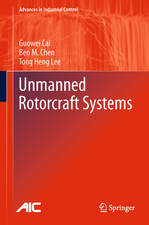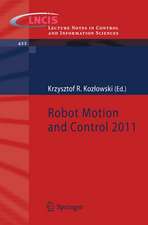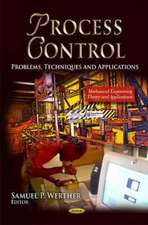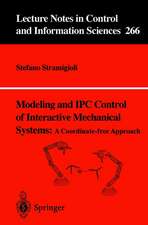Vehicle-Manipulator Systems: Modeling for Simulation, Analysis, and Control: Advances in Industrial Control
Autor Pål Johan From, Jan Tommy Gravdahl, Kristin Ytterstad Pettersenen Limba Engleză Hardback – 16 oct 2013
The first part studies the kinematics and dynamics of rigid bodies and standard robotic manipulators and can be used as an introduction to robotics focussing on robust mathematical modeling. The monograph then moves on to study vehicle-manipulator systems in great detail with emphasis on combining two different configuration spaces in a mathematically sound way. Robustness of these systems is extremely important and Modeling and Control of Vehicle-manipulator Systems effectively represents the dynamic equations using a mathematically robust framework. Several tools from Lie theory and differential geometry are used to obtain globally valid representations of the dynamic equations of vehicle-manipulator systems.
The specific characteristics of several different types of vehicle-manipulator systems are included and the various application areas of these systems are discussed in detail. For underwater robots buoyancy and gravity, drag forces, added mass properties, and ocean currents are considered. For space robotics the effects of free fall environments and the strong dynamic coupling between the spacecraft and the manipulator are discussed. For wheeled robots wheel kinematics and non-holonomic motion is treated, and finally the inertial forces are included for robots mounted on a forced moving base.
Modeling and Control of Vehicle-manipulator Systems will be of interest to researchers and engineers studying and working on many applications of robotics: underwater, space, personal assistance, and mobile manipulation in general, all ofwhich have similarities in the equations required for modeling and control.
| Toate formatele și edițiile | Preț | Express |
|---|---|---|
| Paperback (1) | 950.03 lei 6-8 săpt. | |
| SPRINGER LONDON – 23 aug 2016 | 950.03 lei 6-8 săpt. | |
| Hardback (1) | 962.35 lei 6-8 săpt. | |
| SPRINGER LONDON – 16 oct 2013 | 962.35 lei 6-8 săpt. |
Din seria Advances in Industrial Control
- 15%
 Preț: 643.34 lei
Preț: 643.34 lei - 23%
 Preț: 582.63 lei
Preț: 582.63 lei - 18%
 Preț: 783.98 lei
Preț: 783.98 lei - 18%
 Preț: 947.35 lei
Preț: 947.35 lei - 20%
 Preț: 568.24 lei
Preț: 568.24 lei - 15%
 Preț: 643.16 lei
Preț: 643.16 lei - 18%
 Preț: 899.21 lei
Preț: 899.21 lei - 18%
 Preț: 891.33 lei
Preț: 891.33 lei - 18%
 Preț: 740.57 lei
Preț: 740.57 lei - 18%
 Preț: 961.23 lei
Preț: 961.23 lei - 18%
 Preț: 955.08 lei
Preț: 955.08 lei - 15%
 Preț: 645.28 lei
Preț: 645.28 lei - 15%
 Preț: 638.43 lei
Preț: 638.43 lei - 18%
 Preț: 901.11 lei
Preț: 901.11 lei - 18%
 Preț: 1410.94 lei
Preț: 1410.94 lei - 18%
 Preț: 728.91 lei
Preț: 728.91 lei - 20%
 Preț: 1003.78 lei
Preț: 1003.78 lei - 18%
 Preț: 947.35 lei
Preț: 947.35 lei - 15%
 Preț: 643.34 lei
Preț: 643.34 lei - 15%
 Preț: 654.30 lei
Preț: 654.30 lei - 18%
 Preț: 950.52 lei
Preț: 950.52 lei - 15%
 Preț: 644.30 lei
Preț: 644.30 lei - 18%
 Preț: 1393.09 lei
Preț: 1393.09 lei - 18%
 Preț: 950.21 lei
Preț: 950.21 lei - 18%
 Preț: 949.90 lei
Preț: 949.90 lei - 18%
 Preț: 949.42 lei
Preț: 949.42 lei - 18%
 Preț: 950.52 lei
Preț: 950.52 lei - 18%
 Preț: 1113.71 lei
Preț: 1113.71 lei - 15%
 Preț: 650.04 lei
Preț: 650.04 lei - 15%
 Preț: 644.95 lei
Preț: 644.95 lei - 18%
 Preț: 950.33 lei
Preț: 950.33 lei - 18%
 Preț: 948.61 lei
Preț: 948.61 lei - 18%
 Preț: 1112.60 lei
Preț: 1112.60 lei - 15%
 Preț: 644.63 lei
Preț: 644.63 lei - 18%
 Preț: 953.20 lei
Preț: 953.20 lei - 18%
 Preț: 945.62 lei
Preț: 945.62 lei - 15%
 Preț: 640.88 lei
Preț: 640.88 lei - 15%
 Preț: 640.88 lei
Preț: 640.88 lei - 20%
 Preț: 650.92 lei
Preț: 650.92 lei - 18%
 Preț: 1112.60 lei
Preț: 1112.60 lei - 20%
 Preț: 998.36 lei
Preț: 998.36 lei - 15%
 Preț: 643.34 lei
Preț: 643.34 lei - 18%
 Preț: 948.92 lei
Preț: 948.92 lei - 18%
 Preț: 1381.43 lei
Preț: 1381.43 lei - 15%
 Preț: 651.51 lei
Preț: 651.51 lei - 15%
 Preț: 647.08 lei
Preț: 647.08 lei - 20%
 Preț: 563.66 lei
Preț: 563.66 lei - 18%
 Preț: 992.64 lei
Preț: 992.64 lei - 18%
 Preț: 1225.79 lei
Preț: 1225.79 lei
Preț: 962.35 lei
Preț vechi: 1173.60 lei
-18% Nou
Puncte Express: 1444
Preț estimativ în valută:
184.17€ • 199.98$ • 154.70£
184.17€ • 199.98$ • 154.70£
Carte tipărită la comandă
Livrare economică 23 aprilie-07 mai
Preluare comenzi: 021 569.72.76
Specificații
ISBN-13: 9781447154624
ISBN-10: 1447154622
Pagini: 412
Ilustrații: XXIV, 388 p. 52 illus., 33 illus. in color.
Dimensiuni: 155 x 235 x 25 mm
Greutate: 0.93 kg
Ediția:2014
Editura: SPRINGER LONDON
Colecția Springer
Seria Advances in Industrial Control
Locul publicării:London, United Kingdom
ISBN-10: 1447154622
Pagini: 412
Ilustrații: XXIV, 388 p. 52 illus., 33 illus. in color.
Dimensiuni: 155 x 235 x 25 mm
Greutate: 0.93 kg
Ediția:2014
Editura: SPRINGER LONDON
Colecția Springer
Seria Advances in Industrial Control
Locul publicării:London, United Kingdom
Public țintă
ResearchCuprins
Introduction.- Preliminary Mathematical Concepts.- Rigid Body Kinematics.- Kinematics of Manipulators on a Fixed Base.- Kinematics of Vehicle-manipulator Systems.- Rigid Body Dynamics.- Dynamics of Manipulators on a Fixed Base.- Dynamics of Vehicle-manipulator Systems.- Properties of the Dynamic Equations in Matrix Form.- Underwater Robotic Systems.- Spacecraft-manipulator Systems.- Field Robots.- Robotic Manipulators Mounted on a Forced Non-inertial Base
Textul de pe ultima copertă
Furthering the aim of reducing human exposure to hazardous environments, this monograph presents a detailed study of the modeling and control of vehicle-manipulator systems. The text shows how complex interactions can be performed at remote locations using systems that combine the manipulability of robotic manipulators with the ability of mobile robots to locomote over large areas.
The first part studies the kinematics and dynamics of rigid bodies and standard robotic manipulators and can be used as an introduction to robotics focussing on robust mathematical modeling. The monograph then moves on to study vehicle-manipulator systems in great detail with emphasis on combining two different configuration spaces in a mathematically sound way. Robustness of these systems is extremely important and Modeling and Control of Vehicle-manipulator Systems effectively represents the dynamic equations using a mathematically robust framework. Several tools from Lie theory and differential geometry are used to obtain globally valid representations of the dynamic equations of vehicle-manipulator systems.
The specific characteristics of several different types of vehicle-manipulator systems are included and the various application areas of these systems are discussed in detail. For underwater robots buoyancy and gravity, drag forces, added mass properties, and ocean currents are considered. For space robotics the effects of free fall environments and the strong dynamic coupling between the spacecraft and the manipulator are discussed. For wheeled robots wheel kinematics and non-holonomic motion is treated, and finally the inertial forces are included for robots mounted on a forced moving base.
Modeling and Control of Vehicle-manipulator Systems will be of interest to researchers and engineers studying and working on many applications of robotics: underwater, space, personal assistance, and mobile manipulation in general, all ofwhich have similarities in the equations required for modeling and control.
Advances in Industrial Control aims to report and encourage the transfer of technology in control engineering. The rapid development of control technology has an impact on all areas of the control discipline. The series offers an opportunity for researchers to present an extended exposition of new work in all aspects of industrial control.
The first part studies the kinematics and dynamics of rigid bodies and standard robotic manipulators and can be used as an introduction to robotics focussing on robust mathematical modeling. The monograph then moves on to study vehicle-manipulator systems in great detail with emphasis on combining two different configuration spaces in a mathematically sound way. Robustness of these systems is extremely important and Modeling and Control of Vehicle-manipulator Systems effectively represents the dynamic equations using a mathematically robust framework. Several tools from Lie theory and differential geometry are used to obtain globally valid representations of the dynamic equations of vehicle-manipulator systems.
The specific characteristics of several different types of vehicle-manipulator systems are included and the various application areas of these systems are discussed in detail. For underwater robots buoyancy and gravity, drag forces, added mass properties, and ocean currents are considered. For space robotics the effects of free fall environments and the strong dynamic coupling between the spacecraft and the manipulator are discussed. For wheeled robots wheel kinematics and non-holonomic motion is treated, and finally the inertial forces are included for robots mounted on a forced moving base.
Modeling and Control of Vehicle-manipulator Systems will be of interest to researchers and engineers studying and working on many applications of robotics: underwater, space, personal assistance, and mobile manipulation in general, all ofwhich have similarities in the equations required for modeling and control.
Advances in Industrial Control aims to report and encourage the transfer of technology in control engineering. The rapid development of control technology has an impact on all areas of the control discipline. The series offers an opportunity for researchers to present an extended exposition of new work in all aspects of industrial control.
Caracteristici
Shows the reader how to combine the advantages of maneuverability and manipulability in designing robotic systems that can work at a distance from the operator Explains the characteristics of aerospatial, terrestrial and marine mobile manipulators Demonstrates mathematically rigorous and robust framework for working with robot dynamics Includes supplementary material: sn.pub/extras


















